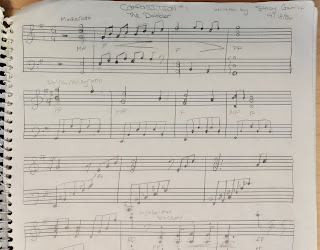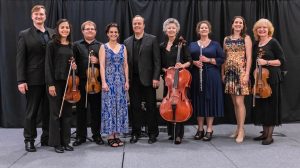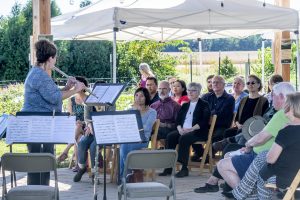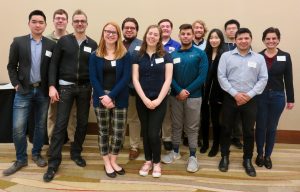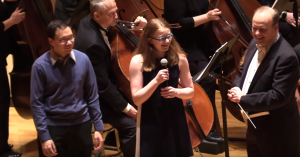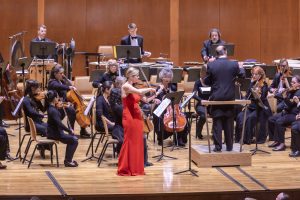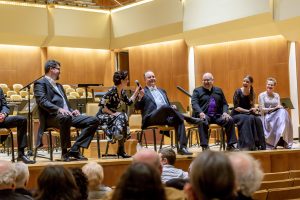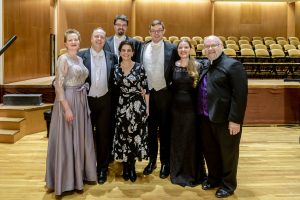The reason
I’m a composer comes down to one person: Mr. Jay Lehmann. Back in the mid-1980s,
Mr. Lehmann directed the instrumental program at Monte Vista High School in Danville,
California. I had been a choir and band geek ever since freshman year, and took piano lessons regularly since the age of five, but the idea of composing
didn’t strike me until junior year when Mr. Lehmann offered an Advanced
Placement Music Theory course. Enrolling in the course was a natural outgrowth of my choral and band geekiness, as well as an opportunity to earn some credits applicable toward a college education -
but taking it changed the course of my life with a single homework assignment,
when Mr. Lehmann said to go home and write a piece of music.
I remember
thinking how difficult that sounded and feeling apprehensive…how could I possibly
compose? Would I have anything to say musically? My trepidation lasted until I
got home and sat down at my family’s piano. While writing that first piece of
music, it felt like a light bulb turned on inside my mind, showing me a room I
had never known existed before, and how that room glowed brightly with
possibilities. It didn’t take long to realize that now that the light bulb had
been turned on, it apparently couldn’t be turned off! Composing was intriguing,
fun, and kept my attention far more than my math and science classes. I began writing
piece after piece about anything that came to mind – a piano waltz for a boy I thought
was cute, a saxophone quartet about soaring eagles… you get the idea. Luckily,
a friend of the family took note and put me in touch with Mr. H. David Hogan, a
composer who lived in the Bay Area, who agreed to take me on as a student. Additionally,
Mr. Hogan sent me to the Walden School for Young Composers, a summer program in
New Hampshire he co-founded in 1972, and whose mission is to train pre-college students
in composition and music theory (Walden is still going strong today, which is a
wonderful testament to the ongoing work of Walden’s administration and faculty
in cultivating today’s youth to compose). Between Mr. Hogan’s studio lessons, my continuing musical activities and classes in high school, and the training I received at the Walden School, my composing abilities
had advanced enough to apply to composition programs in music schools
during my senior year. In the fall of 1988, I entered the University of
Michigan as a composition major, and my career path came into focus.
My origin
story offers a simple point: music teachers are vital in helping students think
in ways they might not inherently do. Would I have discovered composing in some
other way? Not likely. I was already doing a host of musical activities during
high school, and yet hadn’t had any impulse to pick up a pencil and start
scribbling down notes. The question that more often comes to my mind is what
would I have done if I hadn’t discovered composing? It is hard to say, but I’m
relatively sure it wouldn’t be a career in music – while I enjoyed performing, I
had already realized I wasn’t nearly talented enough on any particular
instrument, nor as a singer, to follow a performance path.
This is why I
make it a point to continue doing education activities within a variety of schools,
colleges, and organizations as part of my freelance career. One never knows who
we may inspire through a communal music-making activity, or with some bit of encouragement
we give on a youngster’s composing efforts. When I work with teenagers
(particularly 15-year-olds), I point out that I was their age when I first
discovered my passion for composing. Perhaps they feel like I did – how can
anyone compose? Do they have anything unique to say? Aren’t they too old to
start? – or perhaps they’ll be emboldened to try composing or another
artistic pursuit, seeing how seminal their teenage years can be.
A few months
ago, I found Mr. Lehmann online. He is the Artistic
Director and Conductor of the Berkeley Youth Orchestra, and a professor
at the California Jazz Conservatory
(Berkeley, CA) and Laney College (Oakland, CA), where he teaches all levels of
Music Theory, Ear Training, Jazz History, and Music Appreciation. He has
taught music for the past 48 years, and been honored along the way with the
Golden Bell Award for outstanding teaching in the state of California, as well as a
Lifetime Achievement Award by the National Parent Teacher Association. I sent
him an email, thanking him for giving our class that homework assignment all
those years ago, and letting him know how that one assignment changed the
course of my life (he wrote back – I was a geeky band nerd all over again!).
I’m so thankful Mr. Lehmann was in my life in high school, that he gave our music theory class that particular homework assignment, and then encouraged me to keep composing over the course of my junior and senior years. I hope that I, too, can inspire students to unlock and explore their creative potential, and that our schools
can keep music teachers among their ranks to awaken their students’
imaginations across the country and world.
